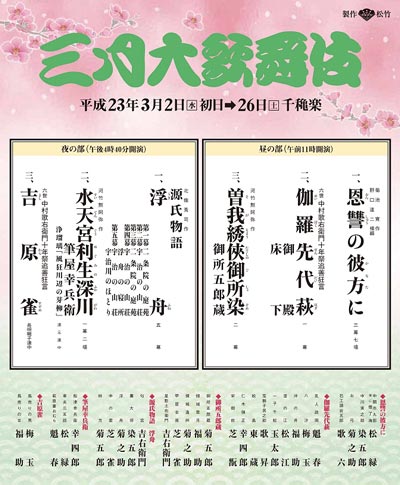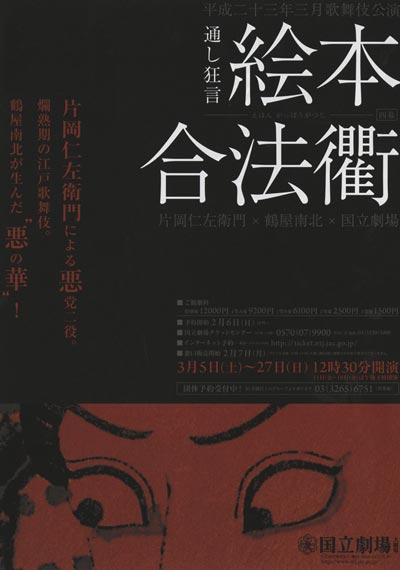| MARCH 2011 |
|
3 shows in T˘ky˘ (Shinbashi Enbuj˘, National Theatre), 1 in Kosaka (K˘rakukan), 1 in Nagoya (Misonoza), 2 in Fukuoka (Hakataza) and 1 show in Ky˘to (Minamiza)!
|
| Shinbashi Enbuj˘ (T˘ky˘) |
| Dates | 2 ~ 26 March 2011 (Sangatsu ďkabuki) March Grand Kabuki |
| MatinÚe |
Onshű no Kanata-ni
|
| Evening | |
| Casting |
Nakamura Shikan, Nakamura Kichiemon, Onoe Kikugor˘, Matsumoto K˘shir˘, Nakamura Shibajaku, Onoe Kikunosuke, Nakamura Kaishun, Nakamura Baigyoku, Nakamura Fukusuke, Nakamura T˘z˘, Onoe Sh˘roku, Ichikawa Somegor˘, Nakamura Karoku, Nakamura Kash˘, Nakamura Matsue, Nakamura Tamatar˘ |
| Comments |
The 10th anniversary of the passing away of Nakamura Utaemon VI is commemorated at the Shinbashi Enbuj˘ with the staging of both "Goten" and "Yoshiwara Suzume":
|
 |
| National Theatre (T˘ky˘) |
| Dates | 5 ~ 27 March 2011 |
| Program | |
| Casting | |
| Comments |
Revival at the National Theatre of Tsuruya Nanboku IV's masterpiece "Ehon Gapp˘-ga-Tsuji".
As a consequence of the 2011 Great Eastern Japan Earthquake Disaster, this program was stopped from the 15th of March! |
 |
|
|||
| Dates | 2 ~ 26 March 2011 (Baiju Hakataza ďkabuki) | ||
| MatinÚe |
Iso Ijinkan |
||
| Evening |
|
||
| Casting |
Nakamura Hashinosuke, Nakamura Senjaku, Band˘ Yajűr˘, Sasano Takashi, Ichikawa En'ya, Nakamura Shichinosuke, Nakamura Kantar˘, Band˘ Shingo |
||
| Comments |
A special program at the Hakataza, commemorating the opening in March 2011 of a 130 km "Shinkansen" bullet train segment between Fukuoka and Yatsushiro, linking the Kyűshű Shinkansen with the San'y˘ Shinkansen.
|
||
|
|||
| Dates | 3 ~ 27 March 2011 (Sangatsu Hanagata Kabuki) March Young Actors Kabuki |
||
| Program | |||
| Casting |
Ichikawa Ukon, Ichikawa Danjir˘, Ichikawa Emiya, Ichikawa Monnosuke, Ichikawa Emisabur˘, Ichikawa Shun'en, Ichikawa En'ya, Ichikawa Juen |
||
| Comments |
Revival at the Minamiza of the spectacular drama "Hitori Tabi Gojűsan Tsugi", which belongs to the Ennosuke Jűhachiban collection of plays. Ichikawa Ukon plays 15 roles in a drama full of keren and hayagawari:
|
||
| Band˘ Tamasabur˘ Tour | |
| Dates | 26 ~ 29 March 2011 (Band˘ Tamasabur˘ Tokubetsu Buy˘ K˘en) Band˘ Tamasabur˘ Special Dance Performances |
| Program |
Yuki Aoi no Ue Kane-ga-Misaki |
| Casting | |
| Comments |
A short Buy˘ tour, starring Band˘ Tamasabur˘ in 3 of his favorite dances. He performs from the 26th to the 27th of March 2011 in Kosaka (Akita prefecture), at the K˘rakukan, the oldest operating traditional Kabuki theatre in Japan (which celebrates its 100th anniversary with these performances). He also performs in Nagoya at the Misonoza the 29th of March 2011. As a consequence of the 2011 Great Eastern Japan Earthquake Disaster, the shows at the K˘rakukan were canceled! |
|
|
| Contact | Main | Top | Updates | Actors | Plays | Playwrights | Programs | Links | FAQ | Glossary | Chronology | Illustrations | Prints | Characters | Derivatives | Theaters | Coming soon | News |
